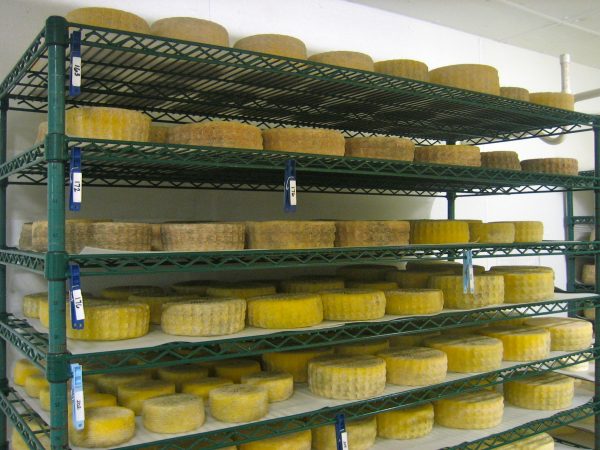For all you lovers of Maggies Round, here is a peek into our work in the aging rooms. All of our cheeses require significant care and attention during the aging process. The day we make the cheese is only the first step, but much of the work comes afterwards….
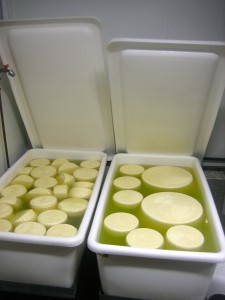 The day after the cheese is made it is placed in a saturated brine. The primary functions of the brine are to stop the process of fermentation, help create a rind, and add salt to the cheese. The brine is made of salt, water, citric acid, and calcium chloride. We like to keep our brine tanks at about 20% salinity, which is high enough that no pathogens will grow in it. We have to add citric acid to the brine so that it is about the same pH as the cheese going into it (the pH of the cheese is generally between 5.2 and 4.9). Similarly, we have to add the calcium chloride to create an equilibrium so that calcium does not leach out of the cheese into the water.
The day after the cheese is made it is placed in a saturated brine. The primary functions of the brine are to stop the process of fermentation, help create a rind, and add salt to the cheese. The brine is made of salt, water, citric acid, and calcium chloride. We like to keep our brine tanks at about 20% salinity, which is high enough that no pathogens will grow in it. We have to add citric acid to the brine so that it is about the same pH as the cheese going into it (the pH of the cheese is generally between 5.2 and 4.9). Similarly, we have to add the calcium chloride to create an equilibrium so that calcium does not leach out of the cheese into the water.
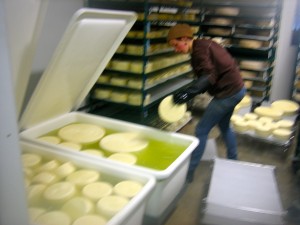
Maggies Round is brined for roughly 1.5 hours per pound of cheese (depending slightly on the shape and size of the cheese). When we take it out of the brine, the cheese is placed on temporary draining racks on the floor. We leave it there for a day or two, so that any residual water drips off of it directly onto the floor, and not onto any other cheese.
Once we place the cheese on the aging racks, we let it sit and develop a nice coating of mold on the rind. The first mold that grows is Geotricum, an environmental white mold. It creates a thin white powdery coating on the cheese. After that  comes blue molds. These are similar blue mold strains that you would find in a blue cheese, except these came from the environment instead of being added to the milk. Following the blue mold we sometimes find Mucor, which is a black mold. Between the establishment of the blue and black molds is the time for the first brushing. Maggies Round requires regular brushing to help the rind develop properly, with the texture, flavor and color that we like best.
comes blue molds. These are similar blue mold strains that you would find in a blue cheese, except these came from the environment instead of being added to the milk. Following the blue mold we sometimes find Mucor, which is a black mold. Between the establishment of the blue and black molds is the time for the first brushing. Maggies Round requires regular brushing to help the rind develop properly, with the texture, flavor and color that we like best.
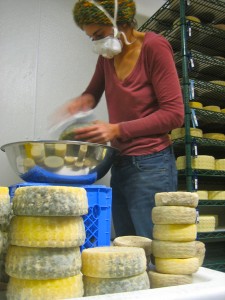 Today Nicole and I brushed mold off the Maggies Round together for about four hours. Each cheese requires careful attention since every one is unique. Placing each wheel of cheese back on the shelf also takes care since we need to maximize space without ever letting two wheels touch each other. Nevertheless, we try to work quickly (even listen to upbeat music to help us move along)! Brushing cheese actually heats up your body quite well – even though it is only 48 degrees in that room, I stripped down to a thin cotton t-shirt since I was so warm. It is good, steady work. It is always surprising to see how much mold comes off of the cheese when it is brushed. It comes off as a powder, and much of it goes up into the air. However, we try to catch as much as possible in our bowls. Throughout the course of the afternoon my pile of mold grew – you can see some in my hand here.
Today Nicole and I brushed mold off the Maggies Round together for about four hours. Each cheese requires careful attention since every one is unique. Placing each wheel of cheese back on the shelf also takes care since we need to maximize space without ever letting two wheels touch each other. Nevertheless, we try to work quickly (even listen to upbeat music to help us move along)! Brushing cheese actually heats up your body quite well – even though it is only 48 degrees in that room, I stripped down to a thin cotton t-shirt since I was so warm. It is good, steady work. It is always surprising to see how much mold comes off of the cheese when it is brushed. It comes off as a powder, and much of it goes up into the air. However, we try to catch as much as possible in our bowls. Throughout the course of the afternoon my pile of mold grew – you can see some in my hand here.
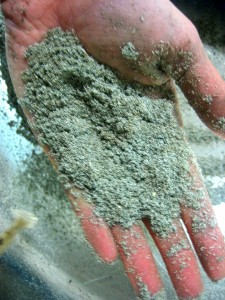
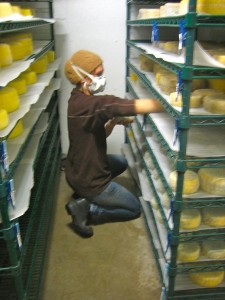 Nicole is the apprentice primarily responsible for the Maggies Round. She does an excellent job making sure that we stay on top of any issues in the aging room, and that all the cheese is properly cared for. Nicole has to keep very careful records of what happens with each batch of cheese. She records in a binder when each batch is brushed, and if there is anything unusual about that batch.
Nicole is the apprentice primarily responsible for the Maggies Round. She does an excellent job making sure that we stay on top of any issues in the aging room, and that all the cheese is properly cared for. Nicole has to keep very careful records of what happens with each batch of cheese. She records in a binder when each batch is brushed, and if there is anything unusual about that batch.
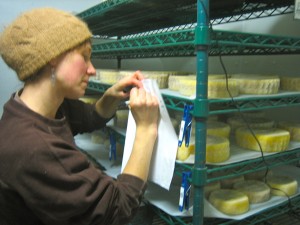 Every batch of cheese we make has a number, and that number follows that batch of cheese throughout it’s life cycle (yes, it is alive!) here at the farm. When each piece of cheese leaves the farm (whether it is a cut piece or a whole wheel going to a chef), that batch number goes with it, either tagged onto the cut piece, or recorded on the invoice.
Every batch of cheese we make has a number, and that number follows that batch of cheese throughout it’s life cycle (yes, it is alive!) here at the farm. When each piece of cheese leaves the farm (whether it is a cut piece or a whole wheel going to a chef), that batch number goes with it, either tagged onto the cut piece, or recorded on the invoice. 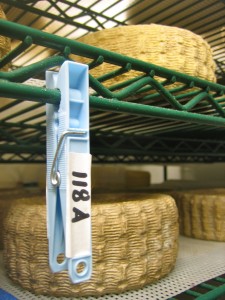 This way we can track where all our cheese is going. We keep the batch numbers on clothes pins so we can easily move them around the room as the cheese moves. It is important to move the cheese around the room often, and flip each wheel over when they move, so they can be exposed to the differences in air flow and microclimates.
This way we can track where all our cheese is going. We keep the batch numbers on clothes pins so we can easily move them around the room as the cheese moves. It is important to move the cheese around the room often, and flip each wheel over when they move, so they can be exposed to the differences in air flow and microclimates.
The care of each cheese we make is incredibly different. The process of taking care of cheese as it ages is called affinage. Much of the flavor and texture of the final cheese comes from the affinage. The person who does this work is called the affineur. In many traditional European agrarian societies, the affineur is a different person than the cheese maker. After the cheese is made, it will go to the affineur for the special care it needs. A New York Times article from last year describes the process like this, “For those who believe the affinage gospel, it is about a series of tedious, ritualized procedures (washing, flipping, brushing, patting, spritzing) that are meant to inch each wheel and wedge toward an apex of delectability.” Even in the United States, there are cheese makers who send their cheese elsewhere to be aged, whether that be a cheese shop (such as Murrays in NYC) or a special aging facility such as the Cellars at Jasper Hill. At Cricket Creek, we age all our cheese ourselves here on the farm so we can do it just as we like it. Hope you all enjoy the finished product!